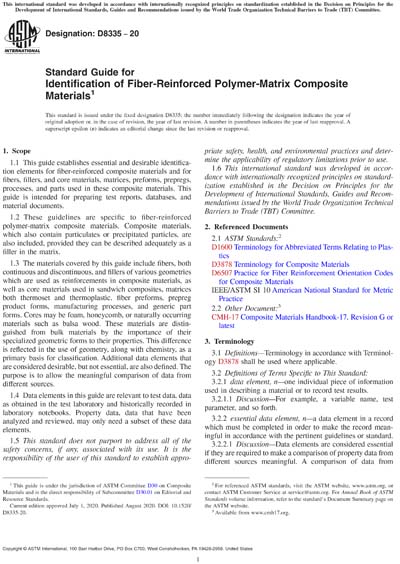Most recent
ASTM D8335-20
Standard Guide for Identification of Fiber-Reinforced Polymer-Matrix Composite Materials
1.1 This guide establishes essential and desirable identification elements for fiber-reinforced composite materials and for fibers, fillers, and core materials, matrices, preforms, prepregs, processes, and parts used in these composite materials. This guide is intended for preparing test reports, databases, and material documents.
1.2 These guidelines are specific to fiber-reinforced polymer-matrix composite materials. Composite materials, which also contain particulates or precipitated particles, are also included, provided they can be described adequately as a filler in the matrix.
1.3 The materials covered by this guide include fibers, both continuous and discontinuous, and fillers of various geometries which are used as reinforcements in composite materials, as well as core materials used in sandwich composites, matrices both thermoset and thermoplastic, fiber preforms, prepreg product forms, manufacturing processes, and generic part forms. Cores may be foam, honeycomb, or naturally occurring materials such as balsa wood. These materials are distinguished from bulk materials by the importance of their specialized geometric forms to their properties. This difference is reflected in the use of geometry, along with chemistry, as a primary basis for classification. Additional data elements that are considered desirable, but not essential, are also defined. The purpose is to allow the meaningful comparison of data from different sources.
1.4 Data elements in this guide are relevant to test data, data as obtained in the test laboratory and historically recorded in laboratory notebooks. Property data, data that have been analyzed and reviewed, may only need a subset of these data elements.
1.5 This standard does not purport to address all of the safety concerns, if any, associated with its use. It is the responsibility of the user of this standard to establish appropriate safety, health, and environmental practices and determine the applicability of regulatory limitations prior to use.
1.6 This international standard was developed in accordance with internationally recognized principles on standardization established in the Decision on Principles for the Development of International Standards, Guides and Recommendations issued by the World Trade Organization Technical Barriers to Trade (TBT) Committee.
Content Provider
ASTM International [astm]






